Content
Large-leaved hydrangea (Hydrangea macrophylla) is a species of the genus Hydrangiaceae. It is a deciduous shrub with a rounded crown, in favorable conditions capable of reaching a height of 4 m. The decoration is not only flowers collected in shields, similar to lace caps, but also large dark green elliptical leaves with a serrated edge. Large-leaved hydrangea varieties with names, descriptions and photos will help you get to know the culture better, and, possibly, choose a new plant for a garden or greenhouse.
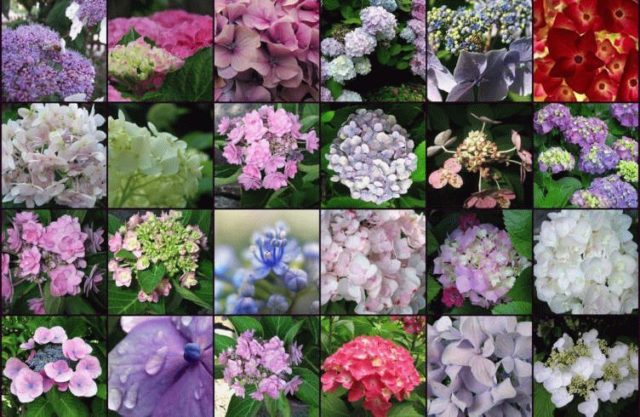
Large-leaved hydrangea varieties are striking in variety
Variety of varieties of large-leaved hydrangea
Large-leaved hydrangea is very decorative. The inflorescences of a species plant reach a diameter of 10-15 cm and are colored pink. On the edge of the shield are large sterile buds, inside - small, but capable of setting seeds.
Through the efforts of breeders, many varieties have been created that differ markedly from each other in the shape and size of the inflorescence, color, and height of the bush. But in all cultivars, you can easily recognize the large-leaved hydrangea.
The shape of the inflorescence is:
- flattened, like a species plant;
- hemispherical;
- spherical.
The "native" color of large-leaved hydrangea is pink. Varieties have been created in which the shields are painted in the following colors:
- white;
- red;
- from blue to purple;
- all shades of pink.
There are bicolor varieties with variegated flowers. Often during the budding period, the scutellum is salad. Green tints can also be present in the color of a fully opened inflorescence.
The breeders did not disregard the size of the bushes. A plant several meters high is not suitable for every garden, and it is difficult to shelter such a hydrangea for the winter. There are miniature varieties that can be grown in containers and in regular flower beds.
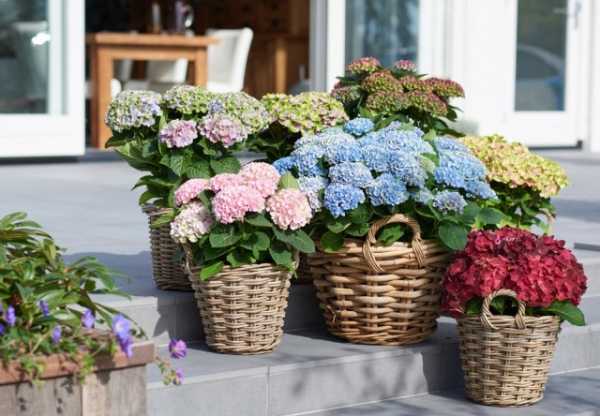
In cool climates, large-leaved hydrangea can be grown in containers
The culture is able to bloom profusely, sometimes the bush is completely covered with flowers. Buds often appear on unrooted cuttings during propagation. But the large-leaved species hydrangea is capricious, makes too many requirements for growing conditions and care to become widespread:
- prefers partial shade;
- grows only on acidic soils;
- requires frequent watering, with cold water;
- for abundant flowering and the formation of large buds, chemical treatment may be required at a certain stage of development;
- hibernates unprotected in climatic zone 6.
It is the last point that allows you to grow crops in open ground only in a limited territory of Russia. For zone 5, a well-thought-out protection of hydrangea from the cold is already needed. Since the bush is rather big, the shelter can disfigure the winter landscape.
The best varieties of large-leaved hydrangea
Choosing the best from the many varieties of hydrangea is a thankless task. The tastes of florists differ, and the culture lends itself well to selection and is very beautiful. But she has a capricious character, strict requirements for the place of planting and care, otherwise a large-leaved hydrangea would grow in every garden. She would even press roses, especially since remontant varieties have appeared.
The color of the hydrangea can be changed. Pink will turn blue or blue with regular feeding with alum, aluminum sulfate, or ferrous sulfate. White will turn into red if the bush is watered with a weak solution of potassium permanganate. When feeding with color-changing preparations is stopped, the color returns to the original one.
Pink miracle
A classic variety with large spherical shields of intense pink color. Large sterile flowers are clearly visible on them. The bush is large, beautiful, similar to a hemisphere, in favorable conditions it can grow up to 2 m. The leaves are oval, with a sharp tip and a serrated edge, large. In summer, their color is bright green, in autumn - crimson.
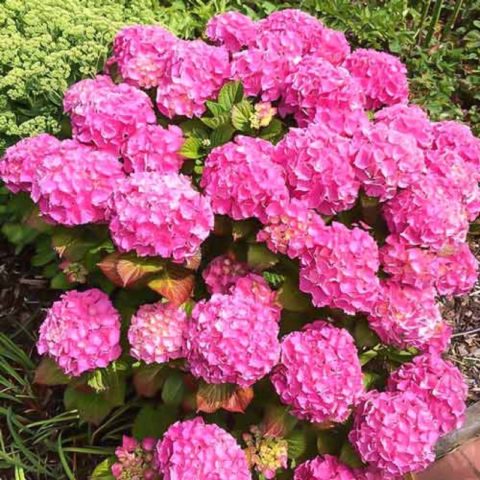
Large-leaved hydrangea variety Pink Miracle can be considered a classic
Endless summer
Endless Summer is a famous American cultivar, the result of natural mutation. Spherical shields, 10-15 cm in diameter, without color-changing preparations are pink. This is the first variety that can bloom well in the current year's growth. Repaired, thanks to which it got its name, is relatively winter-hardy. Bloom - from June to October.
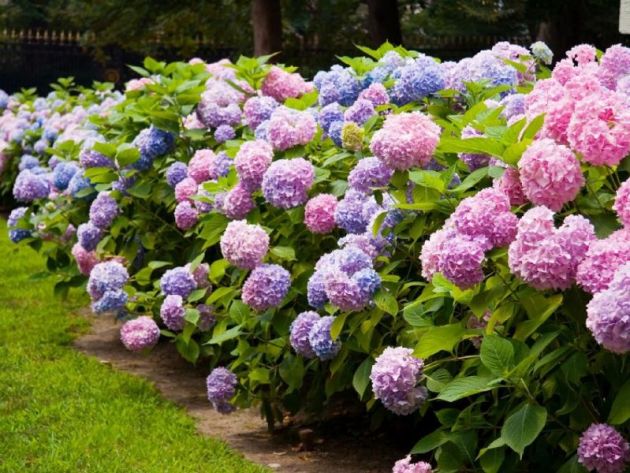
Large-leaved hydrangea Endless summer - the first remontant variety
Waste paper
Maculata, or Mariesi Variegata, is prized for its large green leaves adorned with white strokes. Forms a sprawling bush 80-120 cm high, 1.8-2 m in diameter. It grows without problems in zone 8. At 7, you need to carefully choose a planting site, in cooler climates it requires capital shelter for the winter.
The scutes of the Maculata hydrangea are small but cute. Small central lavender flowers are surrounded by large, almost sterile white petals.
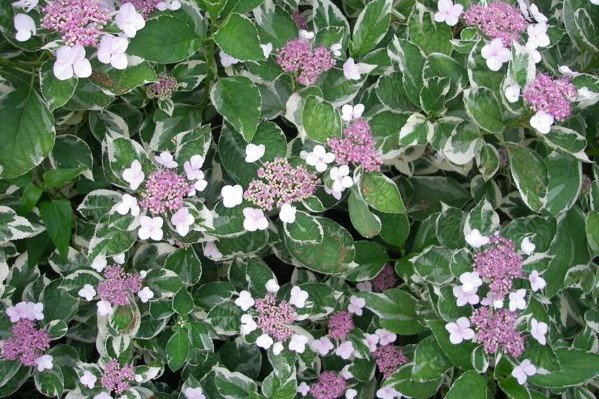
Hydrangea large-leaved Maculata has pretty flowers, but variegated leaves are especially decorative
Flowering varieties of large-leaved hydrangeas
Large-leaved hydrangeas do not have to have pink flowers. And this applies not only to feeding with special preparations that change color. The forms of the shield are varied, and the color can be delicate or saturated. Variegated varieties or those that change color depending on the phase of opening of the buds look especially interesting.
Foreva & Eva Peppermint
Forever & Ever Peppermint impresses with its flower coloration. Without acidifiers, the petals are pink, with a white border. The scutellum of large sterile flowers forms a ball, reaching 25 cm in cross-section. The bush is neat, with dark green shiny leaves, about 90 cm high and wide. Suitable for growing in containers.

Large-leaved hydrangea variety Foreva and Eva Peppermint, when sheltered for the winter, can be grown even in the Moscow region
Snowball
Snowball, or Snow Globe, forms large round snow-white inflorescences that turn pink by autumn. The edges of the petals are decorated with characteristic teeth, which make it difficult to confuse the variety with another. Moreover, the white color in large-leaved hydrangea is rare. The plant forms into a neat, highly branched bush with a diameter of up to 1.2 m. It winters well in zone 5 under cover. Flowering - on the growth of last year.
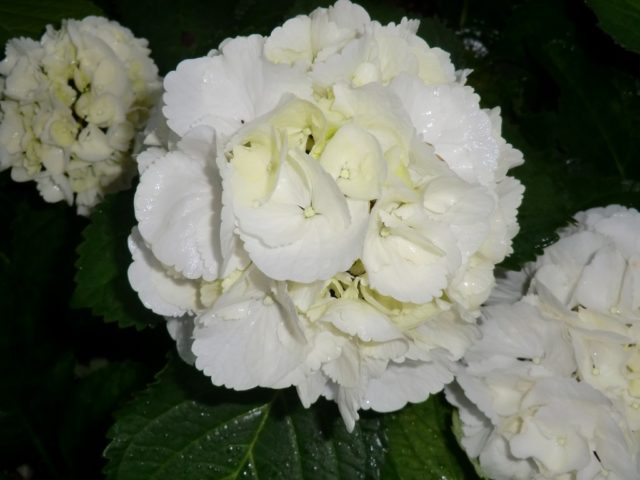
Large-leaved hydrangea Snowball cannot be confused with another variety due to the petals with a jagged edge
Tugese
Together is the original French chameleon variety from the You & me series.The flowers are double, before the buds open - salad, then turn pink. Gradually, the color changes to more and more saturated and at the time of wilting it acquires a pronounced red tint. With regular use of acidifiers, the color of the buds undergoes a transformation from blue to blue.
A young bush with a dozen inflorescences looks impressive. An adult will not leave indifferent even people who are not fans of culture.
Bush 80-100 cm high, with strong thick shoots. Flowering - on the growth of the current year from the end of June, the diameter of the shields is about 20 cm. Frost resistance up to - 25 ° C under cover.
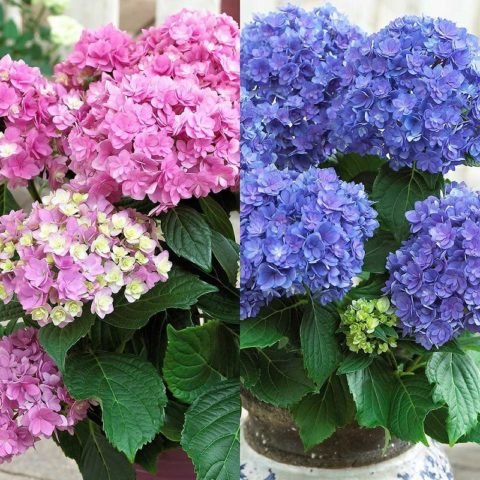
The color of the double flowers of the large-leaved hydrangea variety Tugese depends on the acidity of the soil.
New varieties of large-leaved hydrangea
Large-leaved hydrangea breeding is carried out in several directions. Particular attention is paid to increasing winter hardiness and reducing the size of the bush. But the beauty of flowers is also improved.
Hopcorn
Hopcorn is a new variety named for the similarity of flowers to burst popcorn kernels. Their petals have a well-defined inwardly concave shape. Without feeding with special preparations that change color, the flowers are first salad, then pink, after processing - violet. As it grows, a neat bush is formed up to 1 m in height, with a diameter of 70-100 cm. The variety is resistant to diseases, but makes increased demands on soil fertility.

The large-leaved hydrangea variety Hopcorn has concave petals
Miss Saori
Miss Saori is the newest variety created by Japanese breeders in 2013. In 2014 it won the Chelsea show and was named flower of the year. One of the most cold-resistant varieties that can withstand - 26 ° C.
Forms a neat bush with erect shoots growing up to 1 m high. Differs in large, green leaves with a purple tint. Shields are spherical, flowers are double, white, with a pink border spreading towards the center. The petals are pointed at the ends.
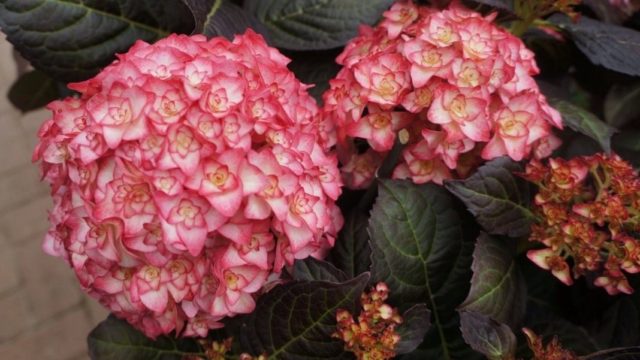
The new Miss Saori variety has unusual flowers, but in the plant you can easily recognize the large-leaved hydrangea
Selma
Selma, unlike other varieties of large-leaved hydrangea, grows slowly, the bush is round, reaches 1 m without pruning. A distinctive feature is the bronze shade of young leaves. When the buds open, the flap acquires a hemispherical shape. The flowers are white in the center, red-pink on the periphery, with noticeable light veins. The tips of the petals are sharp. In the buds that have just begun to bloom, white predominates, as they open and age, it becomes more pink.
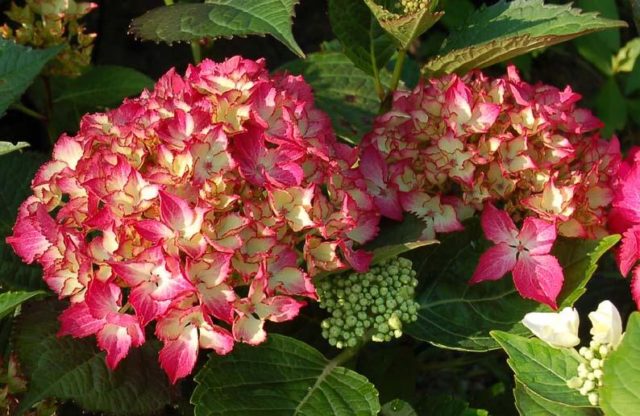
Large-leaved hydrangea Selma is unusually beautiful, grows slowly
Frost-resistant varieties of large-leaved hydrangea
Unfortunately, varieties of large-leaved hydrangea frost-resistant can only be called relatively. In Russia, without shelter, they can grow exclusively in the southernmost regions. Even those varieties that are able to withstand rather low temperatures, it is difficult to tolerate periodic frosts and thaws. Hydrangeas react poorly to cold winds. This means that even frost-resistant varieties are characterized by low winter hardiness.
This must be taken into account when selecting varieties for cultivation in the open field for the inhabitants of the Central strip.
Mars
The Mars hydrangea forms a small shrub about 1 m high. The scutes are a hemisphere with curved edges up to 30 cm in diameter. The flowers are sterile, with rounded, overlapping pink petals. They are edged along the edge with a clear white stripe. The minimum temperature that the variety can withstand is - 28 ° C.
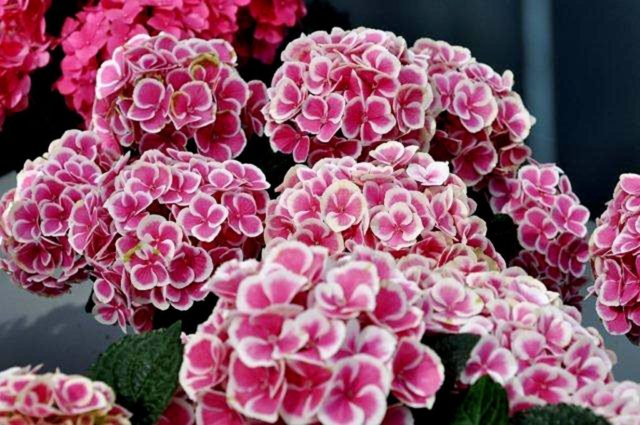
Large-leaved hydrangea Mars variety is distinguished by especially large inflorescences - up to 30 cm in diameter
Bavaria
The new Bavaria cultivar can withstand temperatures as low as -23 ° C. A bush with a height of 1.5 m with erect shoots is formed. Shields are hemispherical, up to 20 cm in diameter. The buds are lime-colored, not salad, retain their color after opening. True, it is much less pronounced, and by the time the flower ages, it disappears. The petals are rounded at the ends, deep violet inside, with clear white veins and the same color with a border around the edge. Flowering - on the shoots of the current and last year.
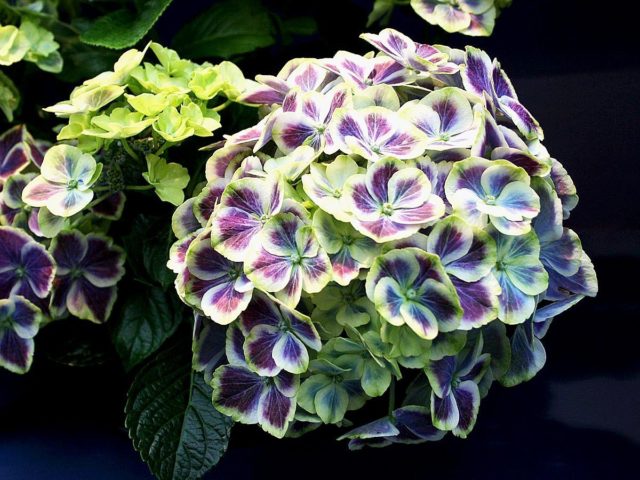
Hydrangea large-leaved Bavaria is a real chameleon with flowers that constantly change color
Twist and Shout
Twist and Shout is a very beautiful variety, the shape of the shield is close to the natural one. It is flat, 10-16 cm in diameter, and consists mainly of small mauve flowers capable of setting seeds. Large, sterile, they are located rarely, along the edge of the scutellum.
The Twist & Shout hydrangea bush reaches a height and diameter of 90-120 cm. The variety is able to withstand temperatures of -29 ° C for a short time.

The shape of the shield of the Twist and Shout cultivar is similar to the inflorescence of the large-leaved hydrangea
Miniature varieties of large-leaved hydrangea
Low-growing varieties of hydrangea are considered large-leaved, the height of which does not exceed 1 m. To actually get a miniature bush, it is restrained by pruning. Just do not overdo it with shortening the stems so as not to damage the flowering, giving the hydrangea an attractive growth for a small area.
Mini Penny
Mini Penny is formed into a bush with a height of 60 to 90 cm with relatively small leaves for hydrangea - 7-15 cm. Shields are hemispherical, 15-20 cm in diameter. On alkaline soils, the color of flowers is pink, when planted in acidic soil, it changes to blue. The buds bloom from late July to September. Winters well in zone 5 under cover.
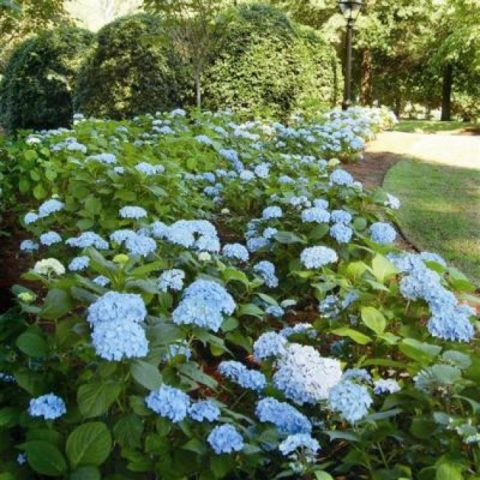
Mini Penny is formed into low bushes
Mireille
Mirei - variety 60-90 cm high, round bush. Dark red spots are clearly visible on the leaves in spring and autumn. The shape of the shields is a distinct hemisphere. The flowers of the original color are white inside, with a crimson edging and the same point in the middle of the corolla. Rhombic petals. Winters in zones 5 and 6. Can be grown in pot culture.

The Mireille variety is one of the most beautiful bicolor hydrangeas
Tovelit
Tovelit grows up to 50-80 cm, sometimes, in especially favorable conditions, the height of an adult bush can reach 1 m. Flowering - on last year's shoots. On alkaline soils, the color of the buds is classic pink. When treated with appropriate preparations and on acidic soils - blue or blue. The scutellum is flat-round, up to 12 cm in diameter. Petals from ovate to rhombic, with a blunt elongated tip. The minimum temperature is 23 ° C.
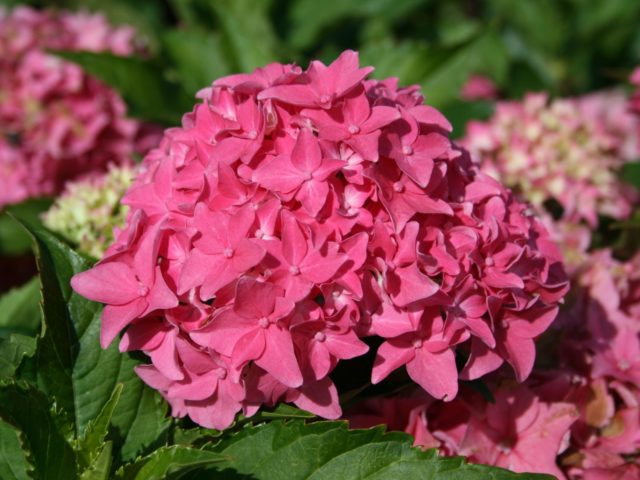
The Tovelit variety has relatively small flowers, only 10-12 cm in diameter.
Conclusion
Varieties of large-leaved hydrangeas with names can only give a general idea of the plant. The culture is very beautiful, prefers partial shade, blooms profusely, each shield does not lose its decorative effect for a long time, which makes the bush seem to be covered with openwork balls. It is a pity that the hydrangea is too thermophilic and capricious.








